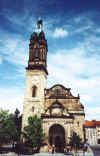|


| |
 |
Eisenach is the town in which Martin Luther studied
as youth (1498-1501); it's also near the Wartburg Castle, where Luther hid
after his hearing at the Diet of Worms (1521). |
Facts and Photos
 Luther
attended St. George's School (1498-1501), originally located near St. George's
Church (photo A, above); the school was torn down in 1507 and relocated in
another part of the city. Luther preached in St. George's church in 1521, on his
way to and from the imperial diet in Worms, although probably not from the
Baroque-style pulpit in photo B (but J. S. Bach was baptized in the font in this
photo). The house where Luther lived (photo C, below), built in the 15th
century, still stands and is a museum today. Luther
attended St. George's School (1498-1501), originally located near St. George's
Church (photo A, above); the school was torn down in 1507 and relocated in
another part of the city. Luther preached in St. George's church in 1521, on his
way to and from the imperial diet in Worms, although probably not from the
Baroque-style pulpit in photo B (but J. S. Bach was baptized in the font in this
photo). The house where Luther lived (photo C, below), built in the 15th
century, still stands and is a museum today.
 Of
Luther's time in Eisenach, James Kittelson writes: "Circumstances changed
somewhat when Luther was sent to Eisenach . . . . There he found relatives on
his mother's side who could keep an eye on him, but were themselves so poor that
they could not even provide shelter. His daily life therefore remained, at least
for a time, more or less the same. He continued to sing in the children's choirs
and had little, if anything, to spend on frivolities. In this he was
indistinguishable from the vast majority of his classmate. At some point during
his stay, however, Luther apparently very much impressed a well-to-do woman from
a family of merchants named Schalbe. The matron of the family arranged for him
to stay at the home of one of her relatives and to take his meals with another.
He may have been required to tutor their children, but after 1498 [at age 15]
life undoubtedly became a bit easier for him" (38-9). Of
Luther's time in Eisenach, James Kittelson writes: "Circumstances changed
somewhat when Luther was sent to Eisenach . . . . There he found relatives on
his mother's side who could keep an eye on him, but were themselves so poor that
they could not even provide shelter. His daily life therefore remained, at least
for a time, more or less the same. He continued to sing in the children's choirs
and had little, if anything, to spend on frivolities. In this he was
indistinguishable from the vast majority of his classmate. At some point during
his stay, however, Luther apparently very much impressed a well-to-do woman from
a family of merchants named Schalbe. The matron of the family arranged for him
to stay at the home of one of her relatives and to take his meals with another.
He may have been required to tutor their children, but after 1498 [at age 15]
life undoubtedly became a bit easier for him" (38-9).
Reflections
We (my parents, Richard and Miriam Carter, and I) stayed at the Gasthof
Storchenturm, near one of the watch towers (Turm is German for tower) in the old
city wall. Our host had the key to the tower and gave a small group staying at
his Gasthof a tour. Inside the circular building was a deep pit that had served
as a prison for an Anabaptist for seven years; he wasn't released after that,
just moved to another prison at the Wartburg. The harsh treatment of Anabaptists
by Lutheran leaders in the 16th century is a reminder that our Lutheran
forebears were sinners as well as saints. Their lack of tolerance for dissenting
views is particularly troublesome in our age which "celebrates
diversity." Excerpts from two Luther scholars help put the Reformers'
attitudes in perspective.
Roland Bainton: "Luther and Melanchthon . . . were quite as much
convinced as was the church of the inquisition that the truth of God can be
known, and being known lays supreme obligations upon mankind [sic] to preserve
it unsullied. The Anabaptists were regarded as the corrupters of souls. Luther's
leniency toward them is the more to be remarked than his severity. He did insist
to the end that faith is not to be forced, that in a private a man [sic] may
believe what he will, that only open revolt or public attack on the orthodox
teaching should be penalized–in his own words, that only sedition and
blasphemy rather than heresy be subject to constraint" (378).
James Kittelson: "As in other instances, Luther here appeared in his
later years to be abandoning the principle of the free preaching of the gospel
for which he apparently had stood during the dramatic encounter at Worms. But
Luther's point was that these people were not preaching the gospel, and
therefore he had to oppose them. . . . He viewed the Anabaptists in particular
as destroyers of the church precisely because they would allow no sinners to be
a part of it" (242-3). |
